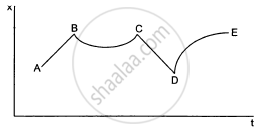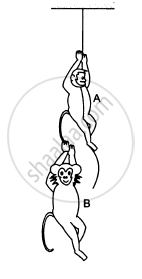Advertisements
Advertisements
Question
A ball is thrown vertically downward with an initial velocity of 10 m/s. What is its speed 1 s later and 2 s later?
Solution
Initial speed of ball = 10 ms-1.
Acceleration due to gravity on ball = - 9.8 ms-2
We know that from first equation of motion
v= u + gt.
After 1 sec
v= 10 - 9.8 X1
v= 0.2 ms-1
so velocity after 1 sec would be 0.2 ms-1.
Velocity after 2 seconds
v= 10 - 9.8X2 = 10 - 19.6 = -9.6 ms-1.
Here negative sign shows that velocity is in downward direction and magnitude is 9.6 ms-1.
APPEARS IN
RELATED QUESTIONS
A body of mass 0.40 kg moving initially with a constant speed of 10 m s–1 to the north is subject to a constant force of 8.0 N directed towards the south for 30 s. Take the instant the force is applied to be t = 0, the position of the body at that time to be x = 0, and predict its position at t = –5 s, 25 s, 100 s.
A helicopter of mass 1000 kg rises with a vertical acceleration of 15 m s–2. The crew and the passengers weigh 300 kg. Give the magnitude and direction of the
(a) force on the floor by the crew and passengers,
(b) action of the rotor of the helicopter on the surrounding air,
(c) force on the helicopter due to the surrounding air.
The figure shows the displacement of a particle going along the X-axis as a function of time. The force acting on the particle is zero in the region

(a) AB
(b) BC
(c) CD
(d) DE
An empty plastic box of mass m is found to accelerate up at the rate of g/6 when placed deep inside water. How much sand should be put inside the box so that it may accelerate down at the rate of g/6?
The monkey B, shown in the following figure, is holding on to the tail of monkey A that is climbing up a rope. The masses of monkeys A and B are 5 kg and 2 kg, respectively. If A can tolerate a tension of 30 N in its tail, what force should it apply on the rope in order to carry monkey B with it? Take g = 10 m/s2.

A force acts for 10 s on a stationary body of mass 100 kg, after which the force ceases to act. The body moves through a distance of 100 m in the next 5 s. Calculate: The velocity acquired by the body.
A force acts for 10 s on a stationary body of mass 100 kg, after which the force ceases to act. The body moves through a distance of 100 m in the next 5 s. Calculate : The magnitude of the force
What do you mean by linear momentum of a body?
Why is it advantageous to turn before taking a long jump?
A metre scale is moving with uniform velocity. This implies ______.
